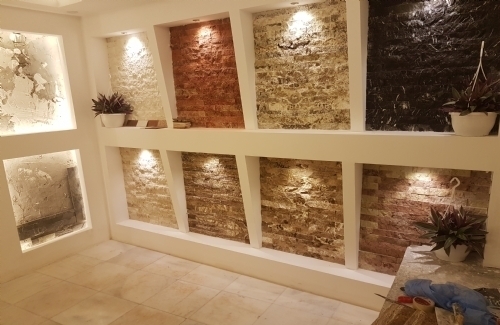
Welcome to our comprehensive guide on Iranian ornamental stones, where we delve into the rich heritage, global significance, and diverse range of ornamental stones that Iran offers. In this content, we aim to:
Introduce the Concept
Highlight Significance
Emphasize Types and Characteristics
1. Iranian Ornamental Stone Heritage
Ornamental stones have been an integral part of Iranian culture and architecture for over two millennia. Islamic architecture in Iran has significantly shaped the use of ornamental stones. Iranian mosques, mausoleums, and palaces feature intricate tile work, stone carvings, and calligraphy that reflect both artistic mastery and spiritual expression.
Iranian ornamental stones are richly symbolic and often appear in Persian poetry, such as the works of Rumi and Hafez. These stones symbolize beauty, spirituality, and the human soul's journey, adding depth to their cultural significance.
2. Ornamental Stones Classification
In general, there are two different ways that rocks are often classified; the first is based on the processes by which they form, in which rocks are classified as either sedimentary, igneous, and metamorphic. Rocks are also commonly classified by grain or crystal size. Accordingly, ornamental or building rocks can be classified into those three primary categories based on their geological origin.
In general, there are two different ways that rocks are often classified; the first is based on the processes by which they form, in which rocks are classified as either sedimentary, igneous, and metamorphic. Rocks are also commonly classified by grain or crystal size. Accordingly, ornamental or building rocks can be classified into those three primary categories based on their geological origin.
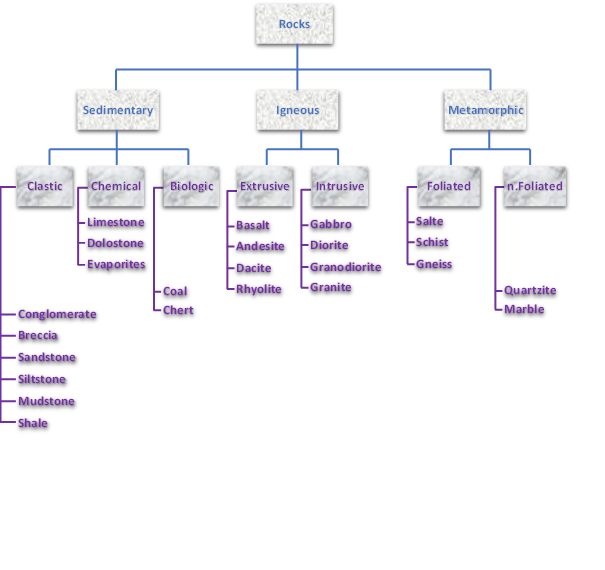
Fig. 1. Classification of Rocks According to their Genesis (Thanks to: https://www.civilsdaily.com/classifications-of-rocks-sedimentary-igneous-and-metamorphic/)
2.1 What are sedimentary rocks?
Sedimentary rocks are formed from deposited and lithified mineral material. They often have a layered or stratified appearance and are known for their aesthetic qualities. Fossils are generally found in sedimentary rock. They are valued for their durability and distinct textures.
Sedimentary rocks can be further classified into three main types based on their origin and composition: clastic, chemical, and biologic (or organic). Each type of sedimentary rock has distinct characteristics and forms under specific geological conditions.
2.1.1 Clastic Sedimentary Rocks
Clastic sedimentary rocks are composed of mineral and rock fragments (clasts) that have been eroded, transported, and deposited by natural processes. These rocks often have a granular texture and are classified based on the size of the clasts and the type of minerals present. Common examples of clastic sedimentary rocks include: Conglomerate, Breccia, Sandstone, Mudstone, Shale
2.1.2 Chemical Sedimentary Rocks
Chemical sedimentary rocks form from the precipitation of minerals from a solution. These rocks are primarily composed of minerals that were dissolved in water and later crystallized as the water evaporated or became oversaturated. Common examples of chemical sedimentary rocks include: Limestone, Dolostone, Evaporites.
2.1.3 Biologic (Organic) Sedimentary Rocks
Biogenic sedimentary rocks are formed from the remains of once-living organisms, such as shells, coral, and plant material. These rocks often contain a high percentage of organic material. Common examples of biogenic sedimentary rocks include: Coal and chart
2.2 What are Igneous rocks?
Igneous rocks are formed from solidified magma or lava. Magma is thought to be generated within the layer of partially molten rock underlying Earth’s crust at a depth below about 60 kilometers (40 miles). Lava is liquid magma on the Earth’s surface, and the solidified rock formed by cooled lava. They are valued for their durability and distinct textures.
Igneous rocks are classified into two main categories based on their mode of formation and where they solidify within the Earth's crust. These categories are extrusive (volcanic) rocks and intrusive (plutonic) rocks. Each category has distinct characteristics and forms under different geological conditions.
2.2.1 Extrusive (Volcanic) Igneous Rocks
Extrusive igneous rocks are formed from the rapid cooling and solidification of molten lava on the Earth's surface. Because they cool quickly, they have fine-grained or glassy textures. Common examples of extrusive igneous rocks include Basalt, Andesite, Dacite, and Rhyolite.
2.2.2 Intrusive (Plutonic) Igneous Rocks
Intrusive igneous rocks are formed from the slow cooling and solidification of molten magma beneath the Earth's surface. They have coarse-grained textures and develop in the deeper layers of the Earth's crust. Common examples of intrusive igneous rocks include Granite, Gabbro, Diorite, and Granodiorite.
2.3 What are metamorphic rocks
Metamorphic rocks are formed when physical and chemical changes through heat and pressure occur to igneous, sedimentary, or other metamorphic rocks. They are known for their unique textures and patterns.
Metamorphic rocks can be classified into two main categories based on their texture and structure: foliated and non-foliated. These categories reflect the way the mineral grains are arranged within the rock and are a result of the metamorphic processes they have undergone.
2.3.1 Foliated Metamorphic Rocks
Foliated metamorphic rocks are characterized by a pronounced alignment of mineral grains along parallel planes, giving them a layered or banded appearance. This alignment is a result of directed pressure and differential stress during the metamorphic process. Foliated rocks often exhibit cleavage, which is the ability to split along the parallel planes. Common examples of foliated metamorphic rocks include: Slate, Schist, and Gneiss
2.3.2 Non-Foliated Metamorphic Rocks
Non-foliated metamorphic rocks do not exhibit a layered or banded structure, and their mineral grains are not aligned along parallel planes. This lack of foliation is often the result of recrystallization and mineral growth under conditions of isotropic (uniform) stress. Common examples of non-foliated metamorphic rocks include: Quartzite and Marble.
3. Types of Iranian Ornamental Stones
3.1 Granite Stone

3.1.1 Description
Granite is used for decorating floors, interior walls, columns, and sculpture facades inside buildings. Granite is an igneous rock known for its high density and hardness, making it a durable building material.
3.1.2 Characteristics
Granite is relatively expensive due to the costs involved in extraction, cutting, and polishing. It is commonly used for building foundations, flooring, and interior decoration. Granite is impermeable, resistant to impact, and waterproof. Its surface can be polished to enhance its attractiveness in construction.
3.2 Quartzite Stone
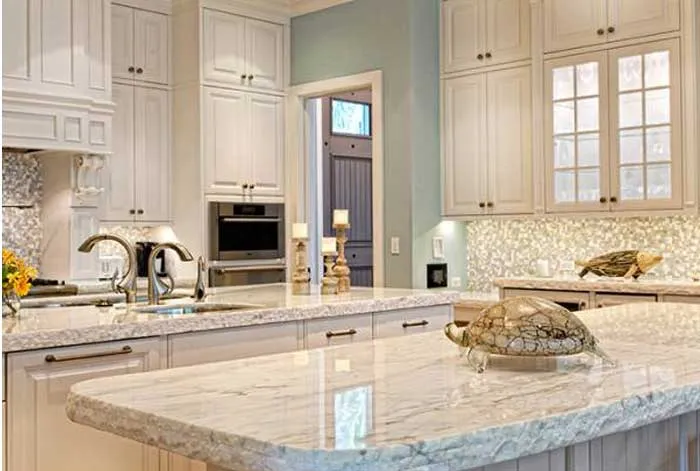
3.2.1 Description
Quartzite stone is used for wall coverings, building facades, staircase surfaces, and flooring because of its high resistance to weathering. This stone is less expensive compared to other stones, making it a cost-effective choice for construction.
3.2.2 Characteristics
Quartzite has a similar appearance to granite but is harder. It has a crystalline, rough texture and comes in various colors, including red, gray, and brown.
3.3 Marble Stone
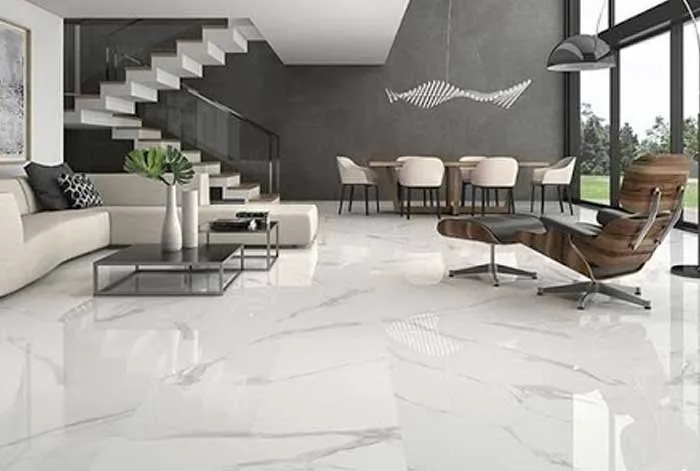
3.3.1 Description
Marble stone has a high polishability and a mirror-like surface. It is used for interior decoration, flooring, columns, staircases, and building ornamentation. However, its low resistance to moisture and pollution makes it unsuitable for exterior cladding.
3.3.2 Characteristics
Marble comes in various colors, such as red, yellow, white, gray, purple, and green. It adds exceptional beauty to buildings but is relatively more expensive than other stones.
3.4 Marbleite Stone

3.4.1 Description
Marbleite stone is distinct from regular marble. It doesn't absorb water but has limited resistance to acid rain and pollution. Hence, it is typically used inside buildings.
3.4.2 Characteristics
Marbleite stone is categorized into multiple groups: marbleite khoy, Kuh-e Sefid, Harsin, Shiraz, Kooh-e Kashan, and Kavosh Kerman.
3.5 Travertine Stone
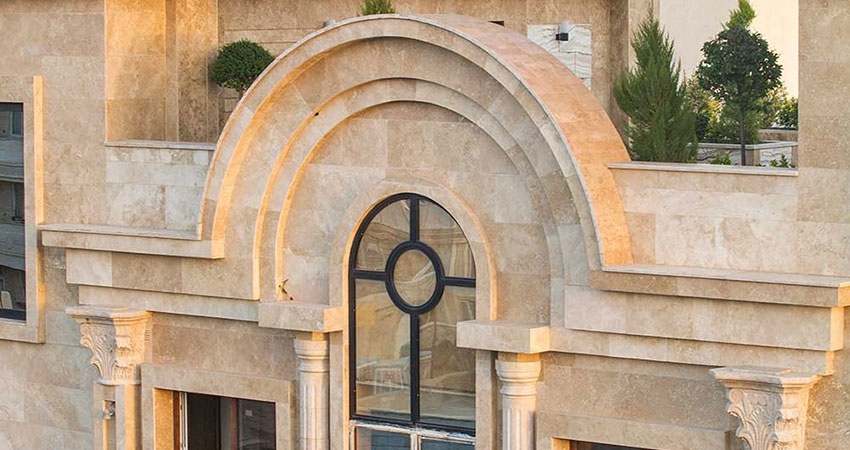
3.5.1 Description
Travertine stone is used for building cladding and interior decoration. In tropical regions, it's also used for exterior building embellishments. Some popular varieties include Stalactite and Stalagmite.
3.5.2 Characteristics
Hajiabad travertine is one of the most famous types, known worldwide. It features cloud-like and wave-like patterns and has exceptional cutting capabilities. Hajiabad travertine is an ideal choice for building cladding and hotel lobbies.
3.6 Sandstone

3.6.1 Description
Sandstone is suitable for both interior and exterior construction due to its high adaptability. It's commonly used for flooring, ceiling coverings, balconies, wall cladding, swimming pools, and patios.
3.6.2 Characteristics
Sandstone is a sedimentary rock created by binding silica grains. It comes in white, gray, reddish-brown, yellow, red, and brown colors.
3.7 Antique Stone
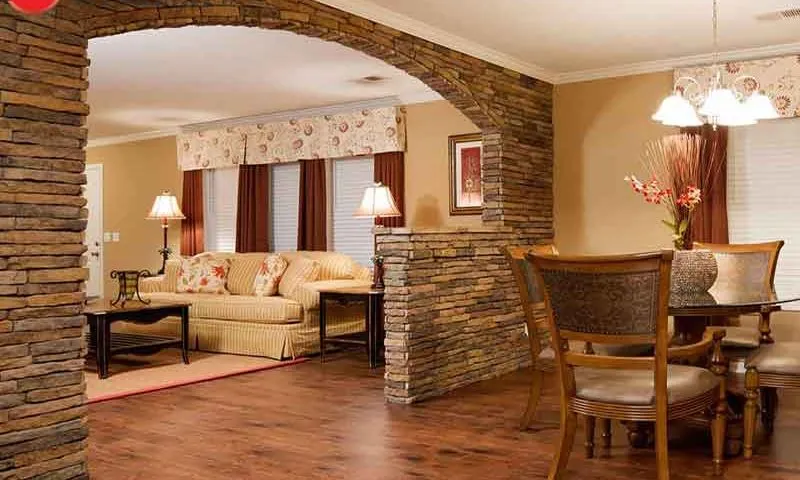
3.7.1 Description
Antique stone is a decorative stone created by placing travertine pebbles next to each other. It's used for interior and exterior building facades and garden landscaping.
3.7.2 Characteristics
Antique stone is used to enhance both interior and exterior building appearances and outdoor landscapes.
3.8 Diorite Stone
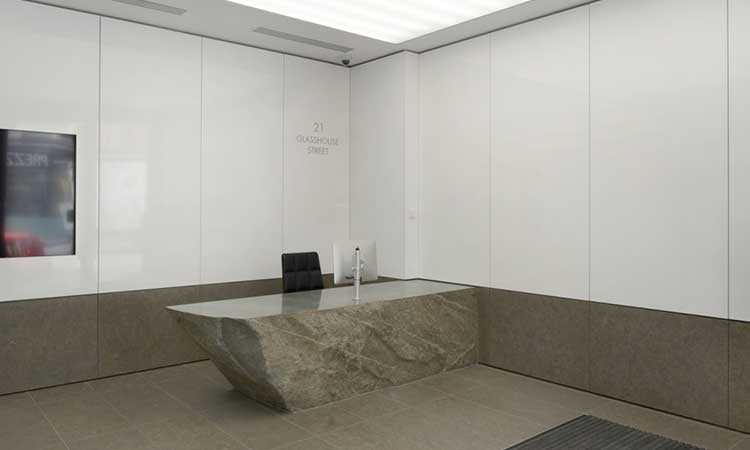
3.8.1 Description
Diorite stone is used for building facades, flooring, and stairs. It comes in various shades of gray, including dark gray and greenish-gray.
3.8.2 Characteristics
Diorite stone, due to its durability and appealing texture, is employed in architectural design.
4. Quality and Expertise
4.1 Diverse Color Variations
These stones offer a wide range of natural colors, from classic whites and beiges to striking blues, greens, and reds, allowing for versatile design choices.
4.2 Unique Texture
Iranian stones exhibit distinctive textures, including polished, smooth, and rough surfaces, offering architects and designers various options to create visually captivating spaces.
4.3 Longevity and Resilience
The quality of these stones ensures that they withstand the test of time, maintaining their aesthetic appeal even in challenging environmental conditions.
4.4 Low Maintenance
The durability of Iranian ornamental stones reduces the need for extensive maintenance, making them a practical and cost-effective choice for construction projects.
4.5 Expertise and Craftsmanship of Iranian Stone Artisans
4.5.1 Rich Tradition
Iranian stone artisans have a centuries-old tradition of working with ornamental stones, passing down their skills through generations.
4.5.2 Artistic Excellence
These artisans bring artistic expression to life through intricate carvings, mosaic work, and precise detailing, transforming stone into works of art.
4.5.3 Customization Expertise
Skilled craftsmen can customize stone products to meet the specific design and size requirements of individual construction projects.
4.5.4 Innovative Techniques
Iranian stone artisans continually adapt and innovate, using cutting-edge tools and technology alongside traditional craftsmanship to meet contemporary design demands.
4.5.5 Preservation of Heritage
Iranian artisans take pride in preserving their cultural heritage by incorporating traditional elements into modern construction and design projects.
4.6 Rigorous Quality Control Processes
4.6.1 Stringent Standards
Iranian stone manufacturers adhere to strict quality control standards to ensure that their products meet or exceed international quality benchmarks.
4.6.2 Comprehensive Testing
These processes encompass various tests, including assessments of color consistency, density, water absorption, and structural integrity.
4.6.3 Consistency in Color and Texture
Quality control procedures guarantee that ornamental stones maintain consistent color and texture throughout large construction projects.
4.6.4 Environmental Sustainability
Many Iranian stone manufacturers incorporate environmentally responsible practices into their quality control processes, reducing their impact on the environment.
4.6.5 Transparency and Certification
The industry is dedicated to providing transparency and documentation for customers, assuring them of the quality and authenticity of the ornamental stones they purchase.
5. Competitive Pricing and Market Presence
Iranian ornamental stones are known for their competitive pricing in the global market. Iran's abundant natural stone resources, including marble, granite, travertine, and limestone, enable the country to offer these stones at a cost-effective rate compared to many other regions.
The cost advantage doesn't compromise the quality of the stones. Iranian ornamental stones are renowned for their high quality, durability, and aesthetic appeal, making them an attractive option for international buyers.
Contact Us
We appreciate your interest in Azar Pouya Tejarat Melal and considering us as your partner in export services. We're committed to providing top-quality products and services to meet your requirements.
If you have any inquiries or are interested in potential collaboration, please don't hesitate to get in touch with us. Our dedicated team is here to assist you with any questions or partnership opportunities. We look forward to hearing from you and exploring how we can work together to meet your needs and objectives.
Let's create something remarkable together!




